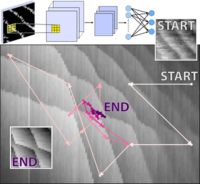当前位置:
X-MOL 学术
›
Phys. Rev. Appl.
›
论文详情
Our official English website, www.x-mol.net, welcomes your
feedback! (Note: you will need to create a separate account there.)
Autotuning of Double-Dot DevicesIn Situwith Machine Learning
Physical Review Applied ( IF 3.8 ) Pub Date : 2020-03-31 , DOI: 10.1103/physrevapplied.13.034075 Justyna P Zwolak 1 , Thomas McJunkin 2 , Sandesh S Kalantre 3, 4 , J P Dodson 2 , E R MacQuarrie 2 , D E Savage 5 , M G Lagally 5 , S N Coppersmith 2, 6 , Mark A Eriksson 2 , Jacob M Taylor 1, 3, 4
Physical Review Applied ( IF 3.8 ) Pub Date : 2020-03-31 , DOI: 10.1103/physrevapplied.13.034075 Justyna P Zwolak 1 , Thomas McJunkin 2 , Sandesh S Kalantre 3, 4 , J P Dodson 2 , E R MacQuarrie 2 , D E Savage 5 , M G Lagally 5 , S N Coppersmith 2, 6 , Mark A Eriksson 2 , Jacob M Taylor 1, 3, 4
Affiliation

|
The current practice of manually tuning quantum dots (QDs) for qubit operation is a relatively time-consuming procedure that is inherently impractical for scaling up and applications. In this work, we report on the in situ implementation of a recently proposed autotuning protocol that combines machine learning (ML) with an optimization routine to navigate the parameter space. In particular, we show that a ML algorithm trained using exclusively simulated data to quantitatively classify the state of a double-QD device can be used to replace human heuristics in the tuning of gate voltages in real devices. We demonstrate active feedback of a functional double-dot device operated at millikelvin temperatures and discuss success rates as a function of the initial conditions and the device performance. Modifications to the training network, fitness function, and optimizer are discussed as a path toward further improvement in the success rate when starting both near and far detuned from the target double-dot range.
中文翻译:

通过机器学习自动调整双点器件
当前手动调整量子点(QD)以进行量子位操作的做法是一个相对耗时的过程,对于扩大规模和应用来说本质上是不切实际的。在这项工作中,我们报告了最近提出的自动调整协议的原位实现,该协议将机器学习(ML)与优化例程相结合以导航参数空间。特别是,我们表明,使用专门的模拟数据训练的机器学习算法可以对双量子点器件的状态进行定量分类,可用于取代实际器件中栅极电压调整中的人类启发式方法。我们演示了在毫开尔文温度下运行的功能性双点器件的主动反馈,并讨论了成功率与初始条件和器件性能的函数关系。讨论了对训练网络、适应度函数和优化器的修改,作为在远离目标双点范围开始时进一步提高成功率的途径。
更新日期:2020-03-31
中文翻译:

通过机器学习自动调整双点器件
当前手动调整量子点(QD)以进行量子位操作的做法是一个相对耗时的过程,对于扩大规模和应用来说本质上是不切实际的。在这项工作中,我们报告了最近提出的自动调整协议的原位实现,该协议将机器学习(ML)与优化例程相结合以导航参数空间。特别是,我们表明,使用专门的模拟数据训练的机器学习算法可以对双量子点器件的状态进行定量分类,可用于取代实际器件中栅极电压调整中的人类启发式方法。我们演示了在毫开尔文温度下运行的功能性双点器件的主动反馈,并讨论了成功率与初始条件和器件性能的函数关系。讨论了对训练网络、适应度函数和优化器的修改,作为在远离目标双点范围开始时进一步提高成功率的途径。











































 京公网安备 11010802027423号
京公网安备 11010802027423号